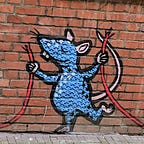Viaje a Espagña — Barcelona
The Fabulous Wife and I spent most of our trip to Spain in Barcelona, the capital of Catalonia. It’s an intensely visual place. The setting alone makes it attractive: a well-scaled city nestled between hills and the Mediterranean Sea.
But Barcelona’s true charm is its street appeal. Joan Miro was born and raised there; Picasso spent his teens and early twenties there; Dali grew up in nearby Figueres and held his first solo exhibition in Barcelona. On the streets, though, the artistic stars are the architects of Catalan Modernisme, including Lluís Domènech i Montaner, Josep Puig i Cadafalch, and the great master, Antoni Gaudí.
Confession: I know little about architecture beyond the fact that architectural critics are second only to wine critics for pomposity. (And speaking of wine, have you tried cava? I realize why I like it more than any wine I’ve had. Instead of hints of this or overtones of that, it tastes like what it’s made of: grapes! But back to architecture.) If what follows proves uninformed, I’ll happily correct it in a subsequent post.
The Modernistas of late nineteenth- and early twentieth-century Barcelona stood at a crossroads. On the one hand, they were heirs to a lofty architectural heritage dating back to ancient Rome.
On the other, they lived at the dawn of the machine age, when new construction methods opened fresh possibilities — at the cost of standardization.
They accepted the techniques of bigger, higher, and more imposing, but rejected uniformity. Their architecture is a metaphor for humanity itself: yes, we are all essentially the same, one big giant mass, but each of us is also different. Thus a series of windows, railings, balconies, or decorations may present a consistent appearance, but when you look at them closely, they vary — mass and individual identity together. Here is Gaudí’s Casa Mila:
Odd-looking, right? That’s because Gaudí preferred curves to straight lines. Once that’s accounted for, the building seems conventionally symmetrical. But take a second look at those balcony railings in front:
Each is different! And now that you’re looking, the domes don’t match, either. The windows don’t always align top to bottom. There’s a second balcony railing on the right side of the top floor, but not on the left. You can spend an afternoon looking at a Modernista building and not have time to appreciate all the unique touches and the craftsmanship behind them.
Gaudí’s masterpiece — and the center of visual Barcelona — is La Sagrada Familia (The Holy Family, i.e. Jesus, Mary, and Joseph), a stupendous basilica that’s been under construction nearly 140 years and won’t be finished for another 15 despite the adoption of time-saving, computer-aided building techniques. No photo does it justice, but that didn’t stop me from trying:
It’s not even close to topping out — the main tower will reach 566 feet — but La Sagrada Familia already dominates the skyline:
The inside is equally imaginative. For instance, the stained-glass designer spent months watching the sun cross the site to devise stunning effects that change by the hour:
We went back to gawk at La Sagrada Familia three times, because it’s a product of humanity’s best impulses — a fusion of art and spiritual longing that ought to be carved onto interstellar probes and launched every day so millions of years from now, other intelligent beings might partake in our noblest hopes and dreams.
This is just a sample of the visual joys Barcelona offers. When you go, hold your nose to block the second-hand smoke. But keep your eyes wide open.
